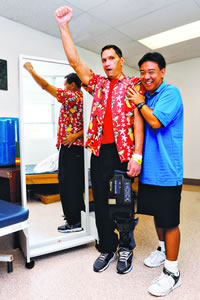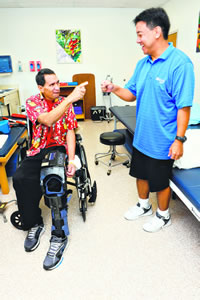Stroke Recovery Assistance
Interviewed by Rasa Fournier
Wednesday - January 25, 2012
E-mail this story | Print this page | Comments (0) | Archive
 Del.icio.us Share
Del.icio.us Share

Dr. Shari Oshiro
Medical director, Stroke Recovery Center of Hawaii at Rehabilitation Hospital of the Pacific
Where did you receive your schooling and training?
I went to Maryknoll High School and John A. Burns School of Medicine. My residency training was done at Mount Sinai Hospital in New York.
How long have you been at REHAB Hospital?
Since 2007.
What is a stroke?
A stroke is sometimes called a “brain attack” and happens when blood flow to a part of the brain stops or there is bleeding resulting in damage to the brain. It is the third leading cause of death and a major cause of long-term disability in the United States.

|
Who gets strokes?
People at risk are those with diabetes, high blood pressure, high cholesterol, cardiac disease, smokers and people with excessive alcohol consumption, which is the equivalent to more than two drinks per day for men and more than one drink per day for women. Other factors include ethnicity, poor nutrition and lack of exercise.
How can you tell when you’re having a stroke?
The most common signs are weakness, numbness, sudden confusion, and difficulty speaking and swallowing. You can also experience dizziness, nausea, vision changes and balance difficulties. One of the classic complaints of someone who is having a bleeding type of stroke is when they say “I have the worst headache of my life!”
If you have any of these signs call 911 immediately. As the American Stroke Association says, “time lost is brain lost.” Do not call your children or other family members first. Call 911 as soon as possible.

|
Can you tell us about the new Stroke Recovery Center of Hawaii?
There have been a lot of new and exciting things going on this past year at REHAB. The hospital is undergoing a large renovation project and part of that effort includes a new neurological rehabilitation unit targeted to open this summer. While traditional therapies such as physical, occupational and speech therapies are still the mainstay of our program, we are now able to offer our patients the opportunity to utilize cutting-edge technologies such as neurorobotics.
These changes have paved the way for us to create a comprehensive stroke recovery center. We are the only place in Hawaii that offers the full rehabilitation program from hospital-based rehabilitation to outpatient therapy to a wellness program. The center allows us to showcase our specialized programs including adaptive driver training, vision therapy, swallow training and bladder training.
The goal of the center is in the name. The word “Recovery” implies more than just improvements in strength or coordination. It is about healing as a whole person, which includes emotions, relationships, interests and hobbies. It translates into a person being able to return to their lives and the community. As a “Center” we are taking a leadership role, defining what the highest standards of care should be.
What are some of the latest techniques used in stroke recovery?
There have been exciting new advances in neurorobotics. We have devices where the patient has to actively initiate the movement and the “robot” helps them to complete the movement. This method activates the brain to forms new connections. This rewiring of nerves within the brain helps the patient to regain control of their affected arm or leg.
Another system that we have acquired is the DASI system for swallow training. A sensor is placed on the throat area and patients are able to see representations of their muscle movements displayed on a computer screen. Through this visual feedback they are able to begin the retraining process to swallow correctly again.
How much of a toll does working all day with people undergoing rehabilitation take on the staff?
Every job has its good days and bad days. The people who are drawn to this field often focus on the positives. The tremendous reward and privilege of helping each patient recover from a stroke, which can be very frightening and life-changing not only for the patient but for their family and friends, is why we chose this profession. That’s what keeps us coming to work every day.
E-mail this story | Print this page | Comments (0) | Archive
Most Recent Comment(s):













